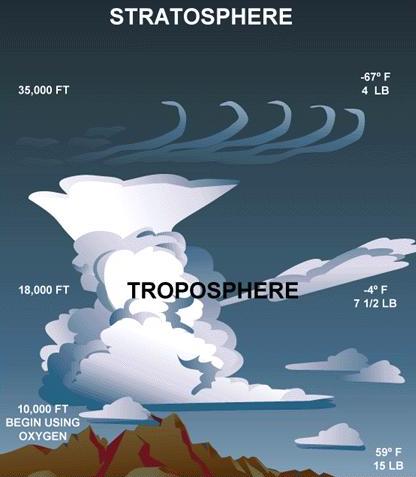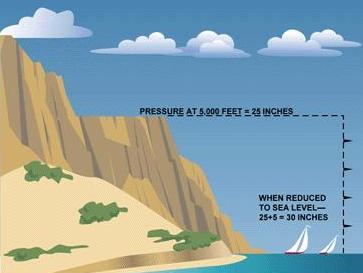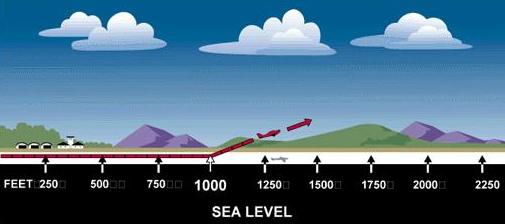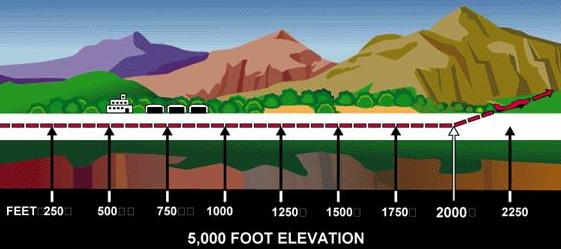| NATURE OF THE ATMOSPHERE
Life exists at the bottom of an ocean of air called the atmosphere. This ocean extends upward from the Earth’s surface for many miles, gradually thinning as it nears the top. Near the surface, the air is relatively warm from contact with the Earth. The temperature in the United States averages about 15° C (59° F) the year round. As altitude increases, the temperature decreases by about 2° C (3.5° F) for every 1,000 feet (normal lapse rate) until air temperature reaches about –55° C (–67° F) at 7 miles above the Earth.
Figure 5-1.—The troposphere and stratosphere are the realm
of flight.
Oxygen and the Human Body The atmosphere is composed of about four-fifths nitrogen and one-fifth
oxygen, with approximately one percent of various other gases. Oxygen is
essential to human life. At 18,000 feet, with only half the normal atmospheric
pressure, the body intake of oxygen would be only half the normal amount. Body
reactions would be definitely below normal, and unconsciousness might result. In
fact, the average person’s reactions become affected at 10,000 feet and may be
affected at altitudes as low as 5,000 feet. Significance of Atmospheric Pressure The average pressure exerted by the atmosphere is approximately 15 pounds per square inch at sea level. This means that a column of air 1 inch square extending from sea level to the top of the atmosphere would weight about 15 pounds. The actual pressure at a given place and time, however, depends upon several factors. These are altitude, temperature, and density of the air. These conditions definitely affect flight. Measurement of Atmospheric Pressure A barometer is generally used to measure the height of a column of mercury in a glass tube. It is sealed at one end and calibrated in inches. An increase in pressure forces the mercury higher in the tube; a decrease allows some of the mercury to drain out, reducing the height of the column. In this way, changes of pressure are registered in inches of mercury (in. Hg.). The standard sea level pressure expressed in these terms is 29.92 inches at a standard temperature of 15° C (59° F). The mercury barometer is cumbersome to move and difficult to read. A
more compact, more easily read, and more mobile barometer is the aneroid,
although it is not so accurate as the mercurial. The aneroid barometer is a
partially evacuated cell sensitive to pressure changes. The cell is linked to an
indicator which moves across a scale graduated in pressure units.
Effect of Altitude on Atmospheric Pressure It can be concluded that atmospheric pressure decreases as altitude increases. It can also be stated that pressure at a given point is a measure of the weight of the column of air above that point. As altitude increases, pressure diminishes as the weight of the air column decreases. This decrease in pressure (increase in density altitude) has a pronounced effect on flight. Effect of Altitude on Flight The most noticeable effect of a decrease in pressure, due to an altitude increase, becomes evident in takeoffs, rate of climb, and landings. An airplane that requires a 1,000-foot run for takeoff at a sea level airport will require a run almost twice as long to take off at an airport which is approximately 5,000 feet above sea level. The purpose of a takeoff run is to gain enough speed to generate lift from the passage of air over the wings.
Figure 5-4.—The distance required for takeoff increases with
the altitude of the field.
Pressure Recorded in “Millibars” The mercury barometer reading at the individual weather stations is
converted to the equivalent sea level pressure and then translated from terms of
inches of mercury to a measure of pressure called millibars. One inch of mercury
is equivalent to approximately 34 millibars; hence, the normal atmospheric
pressure at sea level (29.92), expressed in millibars, is 1,013.2 or roughly
1,000 millibars. The usual pressure readings range from 950.0 to 1,040.0.
Wind The pressure and temperature changes discussed in the previous section produce two kinds of motion in the atmosphere—vertical movement of ascending and descending currents, and horizontal flow known as “wind.” Both of these motions are of primary interest to the pilot because they affect the flight of aircraft during takeoff, landing, climbing, and cruising flight. These motions also bring about changes in weather, which require a pilot to determine if a flight can be made safely. Conditions of wind and weather occurring at any specific place and time are the result of the general circulation in the atmosphere. This will be discussed briefly in the following pages. The atmosphere tends to maintain an equal pressure over the entire Earth, just as the ocean tends to maintain a constant level. When the equilibrium is disturbed, air begins to flow from areas of higher pressure to areas of lower pressure.
|



